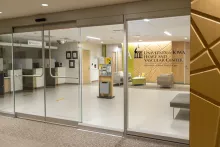Heart Surgery (Minimally Invasive)
- For all other requests:
- 1-800-777-8442
Open-heart surgery is a common operation to fix problems with your heart. But traditional open-heart surgery usually means an extended recovery period, increased trauma to your body, and a higher risk of infection or complications.
That’s why cardiothoracic surgeons at University of Iowa Health Care are dedicated to providing minimally invasive heart surgery options to patients who qualify. In fact, we offer the most robust minimally invasive heart surgery program, including robotic heart surgery, in Iowa. Our surgeons see the most complex patients and perform the most minimally invasive surgeries in the state.
Minimally invasive heart surgery techniques use smaller incisions to reduce scarring, trauma, and the risk of serious complications or infections. This means shorter hospital stays and quicker recovery times to help you get back to the things you love.
What is minimally invasive heart surgery?
Unlike open-heart surgery that involves cutting through the breastbone, minimally invasive heart surgery is performed through small incisions in the chest between the ribs. There are two types of minimally invasive heart surgery: thoracoscopic surgery and robotic heart surgery.
During this procedure, your surgeon will insert small tools into the incisions in your chest. These include a small video camera (thoracoscopic) and long, thin tools to help them see and operate.
Robotic heart surgery also involves small incisions in your chest between your ribs, but the small surgical instruments and camera are attached to thin robotic arms. The surgeon performs the operation at a computer console in the operating room with a high-definition screen showing what the camera can see. The surgeon manipulates a controller to move the robotic arms and performs the surgery.
The robot can be very precise with its movements, allowing the surgeon to perform complex heart surgeries as minimally invasive as possible. Robotic-assisted heart surgery usually results in less pain, a shorter hospital stay, and fewer complications.
What to expect after minimally invasive heart surgery
Recovery time for minimally invasive heart surgeries is often much quicker than open-heart surgeries, allowing you to get back to your usual activities faster. After the procedure, you will need to spend at least one night in the intensive care unit (ICU) for observation.
After that, you will be moved to a regular hospital bed for a few days. The length of your stay will depend on the type of surgery and whether you have any additional health conditions that need to be monitored.
Your surgeon will provide additional care instructions before you’re discharged from the hospital. For the weeks following, you may be more tired than usual and will need to avoid certain activities such as working, driving, or exercising. Most people can return to their regular activities within four weeks.
You will also need regular checkups with your doctor to make sure recovery is going as intended. Your doctor may also recommend a cardiac rehabilitation program to help you develop healthier habits, such as eating a healthy diet, getting consistent exercise, and managing stress.
Who can benefit from minimally invasive heart surgery?
Minimally invasive heart surgery can be a good option for many people with heart conditions that would have traditionally required open-heart surgery, including: ·
- Atrial septal defect (ASD)
- Cardiac tumor
- Coronary artery disease (CAD)
- Atrial fibrillation
- Mitral valve surgery
- Patent foramen ovale (PFO)
- Tricuspid valve surgery
- Aortic valve surgery
If you need heart surgery to treat any of these conditions, your care team will review the following criteria to determine if you are a good candidate for a minimally invasive option:
- Your heart’s condition
- Any lifestyle factors that may affect the surgery or your recovery
- Medical complications that could make the surgery too risky
- Any additional surgeries that may need to be completed at the same time
Our Care Team

Not sure whether the minimally invasive heart surgery is right for you?
Locations and Offices
